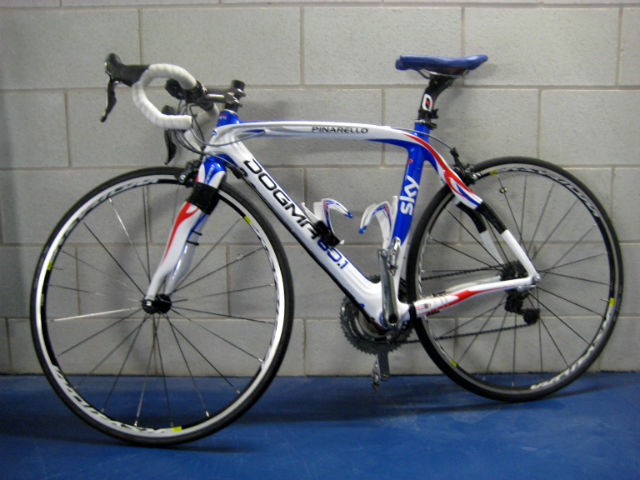I arrive at the London velodrome jaded from a long and mundane journey from the south coast, extended by an unnecessary detour through an East London shopping centre, belt-less security checks, and a shuttle bus journey through a Ballardian landscape of new buildings with design briefs labeled ‘iconic’, known to the wider world as the Olympic Park.
Within moments of entering the velodrome, I receive an answer to the question that has nagged incessantly at me for the previous three hours; one designed to elicit a satisfactory response to the question, “Why didn’t I stay at home and watch this on television?” The atmosphere is electric.
The sound of Guns N’ Roses’ “Welcome to the Jungle” grinds from the PA, but it’s a low guttural roar, not a feature on any version of the song I have heard previously, that brings goose bumps. It builds swiftly to a crescendo and soon drowns out the music entirely. Moments later, as the names of the riders flash on to big screens at either end of the track, I am able to identify the sound as one made instinctively by a British crowd preparing to witness the spectacle of Sir Chris Hoy taking on the world’s elite track cyclists. I’ve arrived just in time.
Yesterday, at the unveiling of the 2012 Team IG-Sigma Sport squad, Dan Craven had spoken of the ‘sensory overload’ he experienced while competing last year in road cycling’s Olympic test event, where he raced for Namibia in front of the thousands who lined The Mall to witness another Great Britain victory. What I imagine to be a similar swamping of the senses occurs now, the intense glare of the spotlights, the throb of the music, the roar of the crowd, and the heat of the velodrome all combining to turn my sensory dial from two to eleven. The atmosphere that had so impressed my colleagues, and even Great Britain’s Olympic champions (Hoy’s post race ‘tweet’ about the noise of the crowd is relayed on the big screen minutes later) has me in thrall.
The starting gun fires to begin heat four of the men’s keirin, a race judged to perfection by Hoy, who unleashes a searing burst of pace to power around the outside of his competitors, moving from fifth to first within a lap to win by inches. The hairs on my arms are stood to attention, and, responding to forces seemingly beyond my control, I cheer and share beaming smiles with complete strangers. I take stock and remind myself that this is the Olympic test event. How the atmosphere will be contained this summer is anyone’s guess.
Watching from high in the stands, Victoria Pendelton appears far below me, gloved and helmeted, clad in full-length tights, bib straps hanging loosely around her waist, riding a road bike in neat circles in front of the podium, seemingly in total silence, the sound of her progress engulfed by the distance, and smothered by the noise of the crowd and the commentator. She appears mute and tiny, lost in her own world; in short, a million miles from any of the mediated incarnations by which we know her: dominant athlete, glamorous poster girl, garrulous interlocutor.
Minutes later, she ascends the short flight of steps from the athletes’ preparation area, closely followed by Jess Varnish. The pair mount their bikes in perfect synchronization. Varnish’s introduction is met by polite applause, which swells to a restrained cheer for Pendleton. Neither compares to the roar that greeted Hoy’s appearance. This seemingly has less to do with the relative popularity of the athletes (Pendleton and Varnish’s gold medal winning ride in the team sprint brought down the same house the previous evening), than from a shared discomfort among the crowd at an enforced face-off between the friends and teammates.
In the first of their encounters, Pendleton leads out and wins comfortably. No words are exchanged between the pair on the warm down lap. Pendleton dismounts almost immediately, removes her helmet, remounts the road bike, and returns to her slow, deliberate circles in front of the podium area. The road machine looks alien beneath her, an aspect that has nothing to do with her riding style, but which provokes the sort of mental double take that might accompany the sight of Roger Federer with a cricket bat. Pendleton has spoken of testing herself in road bunch sprints following her planned, post-Olympic retirement from track racing. Watching her astride the red, white and blue Pinarello, it’s hard not to speculate on her ability to emulate the cross-code success of Wiggins and Thomas, and drag women’s road cycling into the spotlight.
On their second outing, Varnish leads out Pendleton, and responds to a move to the top of the banking in a bid to squeeze out her more experienced rival. The move inspires Pendleton to show her most scintillating pace and pass Varnish from the outside on the final lap to complete a 2-0 victory over her team sprint partner. Varnish stretches out a hand to Pendleton, but realizing her gesture has gone unnoticed, pats her thigh in one-handed applause. This time, the warm down lap is completed together and with broad smiles from both. Pendleton raises Varnish’s hand as they cross the line and the crowd responds at full volume, their discomfort at the enforced rivalry passed, happy to cheer the friends reunited.
The power of sport to transport the individual and energise a nation is not be underestimated. That cycling lies at the heart of a nation’s Olympic hopes is surely a subject for celebration by anyone who cares for the sport. The new Wembley stadium was supposed to be turned into a fortress by the serial failures that make up the nation’s football team. No-one had suggested the tag for the velodrome, but our cyclists have made it one anyway. Now for the Games.


